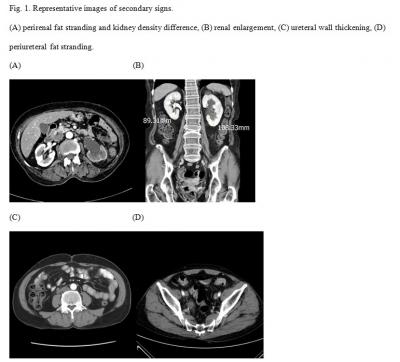|
Cancer - Bladder, Pelvis, Ureter & Others(구연)
|
(E-051)
|
|
|
요관암에서 영상학적 신주변 지방 줄기 변형이 종양학적 예후에 미치는 영향 |
| 경북대학교 의과대학 비뇨기과학교실 |
| 권순오, 장세원, 변경현, 정재욱, 하윤석, 최석환, 김태환, 김현태 |
Purpose: Ureteral urothelial carcinoma (UC) causes gradual ureteral obstruction, resulting in the impairment of renal function. Perirenal fat stranding is defined as linear areas of soft tissue attenuation in the perirenal space which can result from any ureteral obstruction. We analyzed the prognostic impact of perirenal fat stranding sign on the oncologic outcomes in patients with ureteral UC.
Materials and Methods: 126 patients who were evaluated by abdominal-pelvic computerized tomography (CT) preoperatively and were diagnosed with ureteral UC after nephroureterectomy between January 2001 and May 2018 were enrolled in this retrospective study. We analyzed the associations between oncologic outcomes and secondary signs on preoperative CT such as hydronephrosis grade, perirenal fat stranding, renal enlargement, kidney density difference, renal cortical thinning and periureteral fat stranding, etc.
Results: 68 (54.0%) patients had perirenal fat stranding on preoperative CT. Mean age was 66.33 ± 9.49 years. Rate of high pT stage (≥ T3) was 37.3 % (47 patients) and 46 patients received adjuvant chemotherapy. Lymphovascular invasion (LVI) was seen in 15 patients (11.9%). 5 patients were shown to be pN1 stage. Multivariate Cox analysis showed that age, perirenal fat stranding, LVI and pN1 stage were independent prognostic factors of recurrence free survival (RFS) and cancer-specific survival (CSS) and (all P < 0.05). Adjuvant chemotherapy did not show any benefits on RFS or CSS.
Conclusions: Perirenal fat stranding on preoperative CT in ureteral UC was found to be an independent prognostic factor for predicting RSF and CSS. Our findings indicate that immediate radical surgery and adjuvant therapy should be considered in patients with perirenal fat stranding sign preoperatively.
|
 |
|
keywords : urothelial cell carcinoma, perirenal fat stranding, survival |
|

